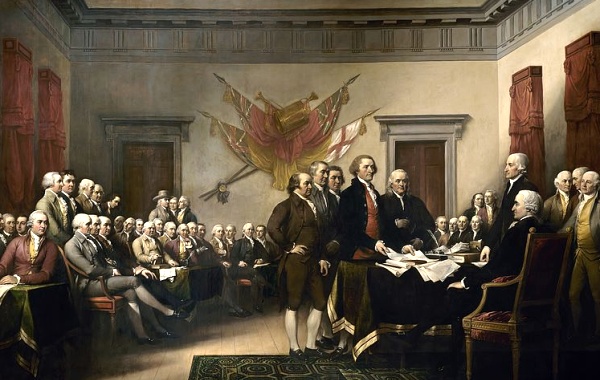17th and 18th Century
Englischsprachige Module für den bilingualen Geschichtsunterricht
Today, the United States of America belong to the most influential nations of the world – politically, economically and culturally. While Native Americans have lived on its territory for millennia, the political predecessors of the U.S. are not much older than 400 years. It may be hard to believe, but it was not before 1607 that the Virginia Company of London established Jamestown, the first successfull British colony on the North American mainland. In the following one and a half centuries, different nations competed for the continent, while the new settlers pushed back the native population, referred to as ‚Indians‘.
 John Trumbull: Declaration of Independence 1776, Gemälde von 1819 | Vollständiges Bild und Bildnachweis (Public Domain, Wikimedia)
John Trumbull: Declaration of Independence 1776, Gemälde von 1819 | Vollständiges Bild und Bildnachweis (Public Domain, Wikimedia)
The British possessions in America were organized in several colonies, small political units with administrative and legislative institutions. Within a relatively short period, they grew substantially in size, number and importance. After several conflicts, England was able to claim the eastern coast of the continent.
The main goal of the British government was to gain profits from their colonies, and one way to do so was to raise taxes. From 1763 onwards, the settlers increasingly protested against the British government and tax policy, that they had no influenco on. In 1775, this conflict escalated into the Revolutionary War between Britain and the so-called ‘Thirteen Colonies’ which united to fight for their independence.
After winning the war against the British in 1783, the revolutionaries attempted to form a new political union, independent from their former colonial rulers. In 1789, the United States Constitution went into effect, soon followed by ten additional amendments in the Bill of Rights. This constitution is still in effect as the supreme law of the U.S. (though 17 more amandments were passed) and provides the framework for its politics today.
Introduction |
||
| 1 | 
|
Do you know the U.S.?
Wissen ◼ leicht | ca. 20 min |
English Settlers in North America |
||
| 2 | 
|
Colonizing the New World
Wissen | Migration ◼ ◼ mittel | ca. 30 min | optionale Aufgabe: 20 min |
| 3 | 
|
Pilgrims
Verstehen und urteilen | Migration ◼ ◼ mittel | ca. 20 min | optionale Aufgabe: 20 min |
| 4 | 
|
Picturing Thanksgiving
Quellen untersuchen: Gemälde | „Wir“ und „Fremde“ ◼ ◼ mittel | ca. 20 min | optionale Aufgabe: 10 min |
| 5 | 
|
The Thirteen Colonies
Wissen | Kolonialismus ◼ leicht | ca. 20 min |
The American Revolution |
||
| 6 | 
|
Conflict with Britain
Wissen | Proteste und Aufstände ◼ ◼ mittel | ca. 30 min | optionale Aufgabe: 10 min |
| 7 | 
|
Depicting the conflict – a British perspective
Quelle untersuchen: Karikatur | Proteste und Aufstände ◼ ◼ mittel | ca. 30 min |
| 8 | 
|
Revolutionary War
Klassenmodul | Krieg ◼ ◼ mittel | ca. 90 min |
The United States Constitution |
||
| 9 | 
|
Declaration of Independence
Gegenwartsbezug | Mediengeschichte ◼ ◼ ◼ schwer | ca. 40 min | optionale Aufgabe: 20 min |
| 10 | 
|
„A more perfect union“?
Schaubild | Demokratie ◼ ◼ mittel | ca. 30 min |
| 11 | 
|
Becoming the U.S. President
Verstehen und urteilen | Demokratie ◼ ◼ ◼ schwer | ca. 30 min | optionale Aufgabe: 20 min |
Minorities in the American colonies |
||
| 12 | 
|
Trail of Tears | Native Americans
Verstehen und urteilen | Ausgrenzung und Verfolgung ◼ ◼ mittel | ca. 30 min |
| 13 | 
|
Atlantic Slave Trade | Video
Verstehen und urteilen | Brutalität und Menschenrechtsverletzung ◼ ◼ mittel | ca. 30 min |
|
Nach Abschluss einer Modulserie sollst du hier deine Ergebnisse und deinen Lernerfolg selbst evaluieren (das heißt: kritisch beurteilen) Die Zeitangaben geben eine Orientierung für die Bearbeitungsdauer der Module Bildnachweise zu den Vorschaubildern in den Lernmodulen Methode | Thema | Schwierigkeitsgrade: ◼ leicht ◼ ◼ mittel ◼ ◼ ◼ schwer (auch Oberstufe) |
||
Autoren dieser Modulserie: Astrid Wegner, Simon Grigo, Köln
